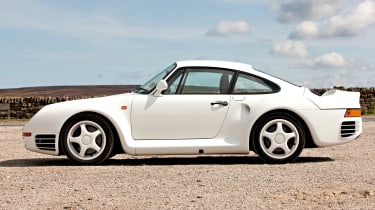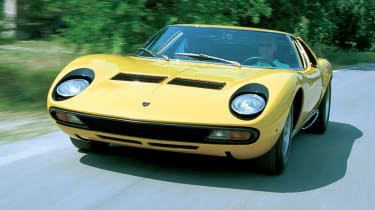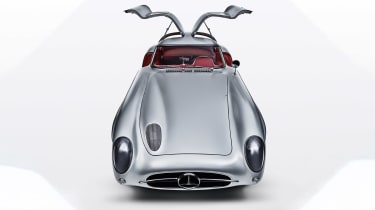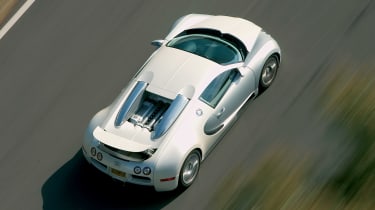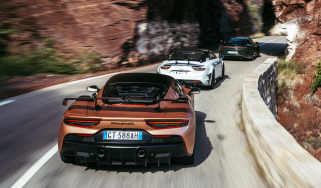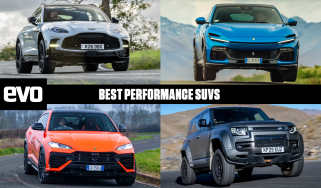How to design a car (part ten): what is a supercar?
The Mercedes-Benz 300 SLR Uhlenhaut Coupe that recently sold for a record £114million is definitely a supercar. But what else qualifies?
I have recently noticed an ever-increasing amount of internet chatter about what makes a sports car into a ‘supercar’ or even a ‘hypercar’.
The exchanges of opinions quickly become heated, sneering or even abusive. What is it that stirs such passion in people that they feel forced to loudly trumpet their own opinions while savaging those who think differently?
I think that most evo readers could go through a set of images of high-performance cars and calmly say ‘yes, yes, no, no, yes’ as to their deserving to be described as ‘supercars’, without feeling the need to justify their views with a drawn sword. It is a bit like having to describe the difference between a dog and a cat; we know one when we see it without having to go into the minutiae of details of teeth or whiskers.
In a typical recent internet exchange, the gauntlet was thrown down thus: ‘The Porsche 959 competed at Le Mans and is a Paris-Dakar winner, a Group B study that became a German technology demonstrator with a poster presence in teenage youths’ bedrooms. A flat-six engine at the rear, challenging in appearance from some angles, to the untrained eye it’s just a 911. A fantastic car, the über-GT of the eighties, but not a supercar.’ The language has been slightly changed to protect both the innocent and the guilty.
> Bugatti Veyron - review, history, prices and specs
And then come the responses: ‘Not a supercar, it’s a step above supercars. A technological marvel.’
‘So, by your definition the XJ220 isn’t either, as it also has a six-cylinder engine.’
‘220 was meant to have a V12, so it’s a supercar.’
‘Does that mean it’s not a supercar because it’s not mid-engined, so how about the McLaren Mercedes SLR, 599 GTO and Aston One-77?’
‘I don’t mind if it’s not a supercar, I just love it.’
‘Your opinion of what makes a supercar is purely subjective as there is no agreed upon definition and it is rather arrogant for you to declare what is and is not a supercar.’
‘XJ220 and 911 GT1 are both good examples of 6-cylinder supercars. 959 isn’t.’
‘Blah Blah Blah… whatever. You are wrong.’
‘Look at the 300SL Gullwing, front engine with an in-line 6-cylinder engine, a lot of people regard that as the first supercar.’
‘Our generation has some obsession with calling everything “super, hyper, ultra, mega”. It’s comical.’
‘If you think the 959 isn’t a supercar then you know nothing about cars. Prove me wrong, I can’t wait for you to try.’
‘I think you are doing a great job with fan engagement. Controversy sells lol.’
And on and on for pages.
Wikipedia suggests that ‘the Lamborghini Miura, produced from 1966-1973, is often said to be the first supercar. By the 1970s and 1980s the term was in regular use, if not precisely defined. One interpretation up until the 1990s was to use it for mid-engine two-seat cars with at least eight cylinders (but typically a V12 engine), a power output of at least 400bhp (298kW) and a top speed of at least 180mph (290km/h). Other interpretations state that “it must be very fast, with sporting handling to match”, “it should be sleek and eye-catching” and its price should be “one in a rarefied atmosphere of its own”, while “possessing exclusivity is seen as an important characteristic (i.e. limited production volumes)”.
‘It is also claimed that the definition of a supercar has always been subjective and is a matter of blind prejudice.’
Back in 1920, the London newspaper The Times used the word ‘supercar’ to try to describe the 6.7‑litre Ensign 6 as being of speed and style beyond that of other cars.
In the US during the 1960s, cars that are now considered to be muscle cars were then referred to as supercars, apparently sometimes written with a capital S. The May 1965 issue of the American magazine Car Life included multiple references to supercars and ‘the supercar club’ and a 1968 issue of Car & Driver magazine apparently referred to ‘the Supercar street racer gang’.
To my mind, if we ignore high performance sports cars from before the Second World War then the first truly impressive supercar must be the 1955 Mercedes 300 SLR Uhlenhaut Coupe. This was a development of the 1954 300 SL ‘Gullwing’ that was designed by chief motorsport engineer Rudolf Uhlenhaut. It has everything that a super car should embody in the way of advanced technology: a race-derived straight-eight engine with desmodromic, mechanically closed valves, a five-speed rear-mounted transaxle, an ultra-lightweight body and those unique gullwing doors. And of equal importance it looked spectacular. A story about an Uhlenhaut drive from Munich to Stuttgart taking just over an hour for the 220km (137-mile) trip gives the car serious credibility.
This puts the Lamborghini Miura into second place in the claims to have been the first of a new breed of high-performance sports car. If we apply the test of great looks and advanced technology then, whilst the ‘looks’ are apparent, a transverse V12 engine was not a trendsetter. Later, Ferrari’s F40 was a car that most immediately described as a supercar, though it was quite crude in some ways. Lamborghinis, whilst defined by their extreme looks, were generally not useable in a grand touring sense, and this is where opinions can divide: is practical or impractical part of the definition? A 959 Porsche is a technological masterpiece and, like the 918 and Carrera GT, is useable in all road conditions; they will take you there and bring you back with luggage and a feeling of invincibility. But does that make them more or less super?
After the challenging and slightly rustic F40, the McLaren F1 certainly appeared to break new ground with its superb motor, discreet aerodynamics and carbon construction, although as a carbon road-car it was preceded by the limited-production Jaguar XJR-15. Both UK-built supercars? Yes.
The more recent proliferation of very high-performance sports cars that are all described as ‘supercars’ by different magazines begins to need serious pruning at this point. There are a number of cars that are great machines but just don’t feel like they are special enough to merit the term under discussion. Ferrari 488 GTB, Lotus Esprit V8, Noble M600 and Nissan GT-R have all been described as supercars in various magazines, but none of them induces that sense of astonishment that a Ferrari Enzo, Bugatti Veyron or McLaren P1 can do (I find it hard to take a car called ‘Ferrari LaFerrari’ seriously, so Enzo is my Ferrari reference here). Incidentally, the P1 creates a problem for McLaren because if that car is the pinnacle of recent McLaren models then logic suggests that any more recent models cannot be ‘supercars’ however fast they are.
It is here that prejudice comes into the discussion. I have never really felt anything other than a passing curiosity for any recent Bugatti. Certainly they are mind-bogglingly complex and fast – my brave friend Andy Wallace has proved that with a top speed of 304mph – but they just don’t capture one’s heart.
What is clear from looking at the more recent entrants to this rarefied or non-existent club is that almost all of the talk is around mid- or rear-engined cars. How do front-engined cars fit into this debate? Black Series Mercedes are too near to their regular production models in terms of looks and components to be that special; the Corvette’s change from front to mid motor has not elevated them to the top class; the Dodge Viper with its pick-up truck engine was never going to make it; Aston Martins are glorious Grand Tourers and front-engined Ferraris can’t really trump their mid-engined siblings, gorgeous though the Roma is.
The Audi R8 is a beautiful piece of engineering, a fine example of great product design and a very accomplished machine in dynamic terms, but accomplishment does not necessarily make a supercar. Instead it is something that stirs the soul, delights the eye and celebrates engineering.
This story was first featured in evo issue 299.
